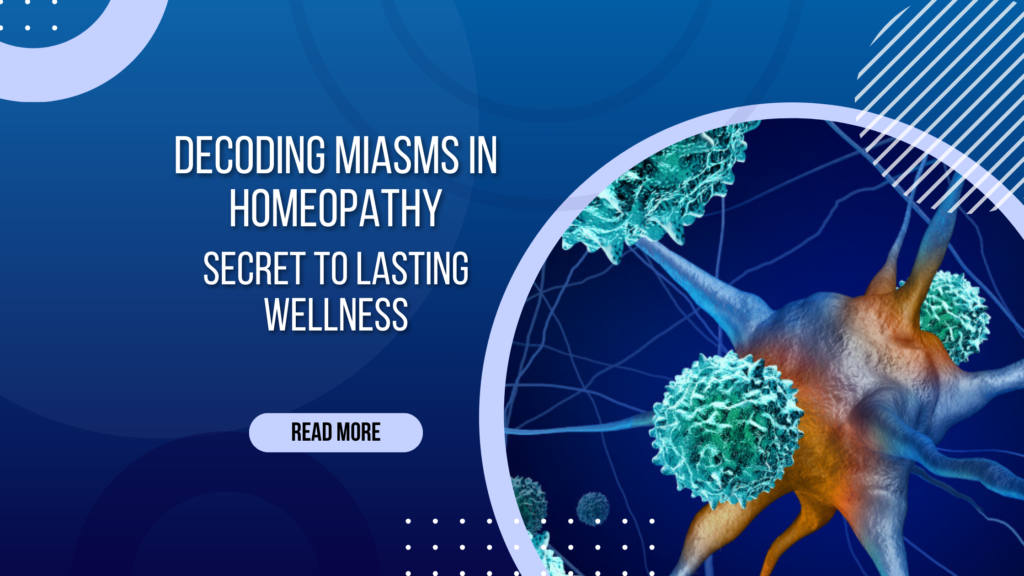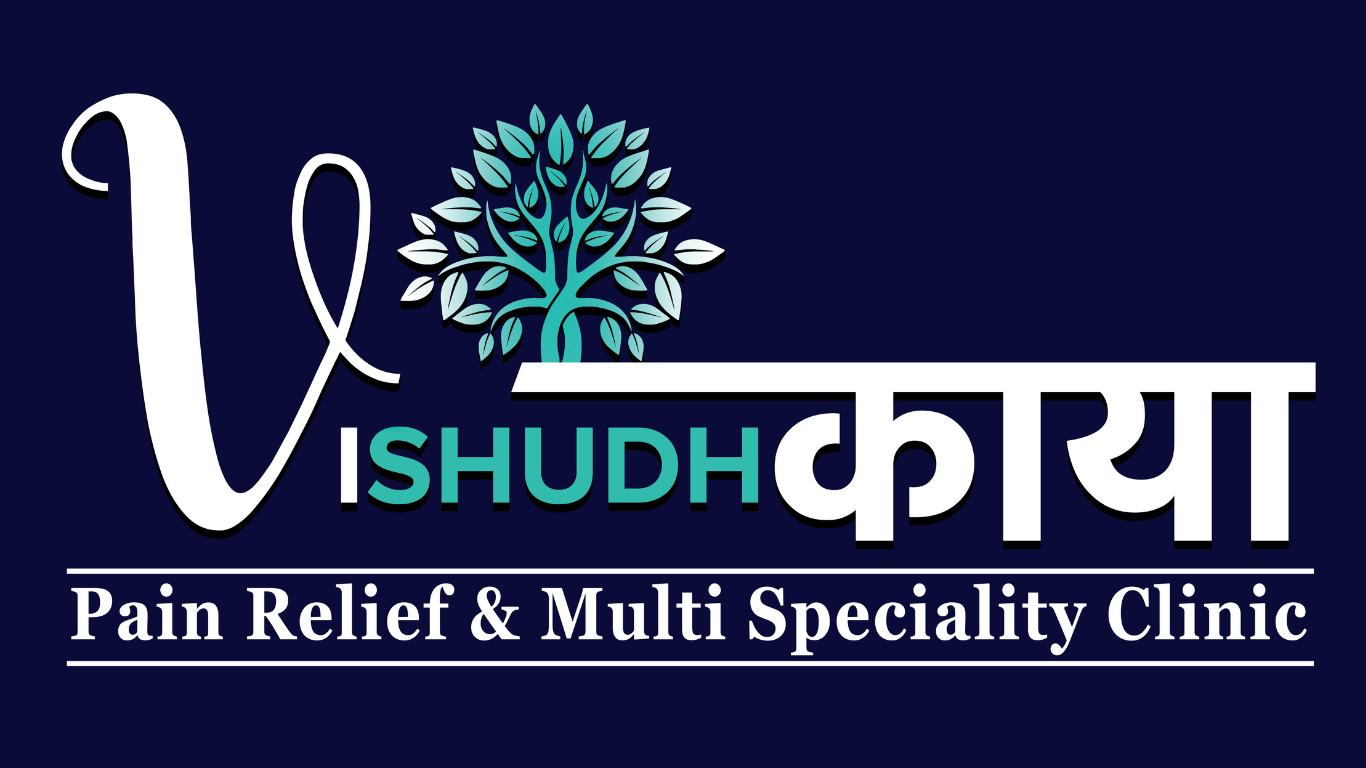Introduction:
Homoeopathy is a distinct system of medicine founded by Dr Samuel Hahnemann (1755-1843) – a German physician born in Meissen in Saxony of Germany, best known as the founder of homoeopathy that operates on the intriguing principle of Similia Similibus Curanter i.e. “as cures like.” This philosophy posits that a substance that can induce specific symptoms in a healthy individual can when administered in a highly diluted form, serve as a remedy for similar symptoms manifesting in someone unwell. This approach emphasizes the body’s innate ability to heal itself, guided by carefully selected homoeopathic remedies.
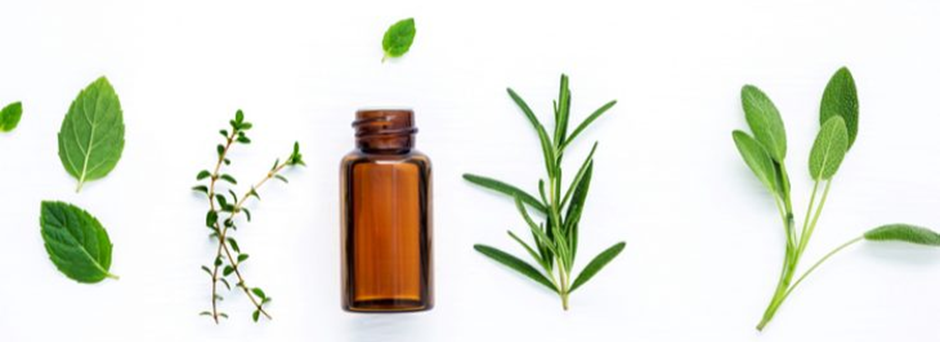
The concept of miasms, introduced by Samuel Hahnemann—the pioneering figure behind homoeopathy—provides a deeper understanding of chronic diseases. Hahnemann theorized that these long-lasting ailments are not merely the result of external influences such as bacteria or viruses. Instead, he proposed that they arise from profound, internal disturbances within the individual particularly the disturbance of Vital Force, which he referred to as miasms. These miasms represent a lingering influence that disrupts the body’s natural state of health, suggesting that true healing must address these underlying constitutional imbalances.
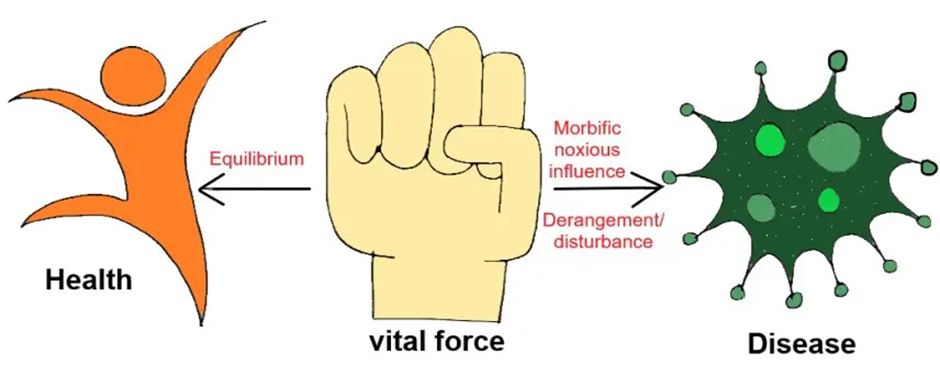
The Importance of Understanding Miasms in Treating Chronic Diseases
The notion of miasms is a distinctive element of classical homoeopathy, yet it’s essential to recognize that this idea is not acknowledged or endorsed by contemporary mainstream medicine. The effectiveness of homoeopathic remedies is also a subject of scientific controversy. Nevertheless, within the framework of classical homoeopathy, comprehending miasms is deemed significant for the treatment of chronic illnesses for the following reasons:
1. Clarifying Disease Vulnerability: Miasms are thought to make individuals more prone to specific chronic conditions. By examining a patient’s miasmatic history homoeopaths strive to understand why someone may be inclined toward certain health issues.
2. Targeting the Fundamental Cause: Homeopaths contend that miasms signify the constitutional origins of chronic ailments, rather than merely the symptoms that present themselves. Thus, treatment is centred on addressing this fundamental cause instead of just alleviating the symptoms.
3. Personalized Treatment: Miasmatic theory enables a more tailored approach to medicine. By taking into account a patient’s miasm alongside their physical, emotional, and psychological symptoms, homoeopaths seek to find the most fitting remedy for that person.
4. Identifying Treatment Barriers: In some instances, a carefully chosen homoeopathic remedy may not achieve lasting effects. The miasmatic theory posits that this may be due to an underlying miasmatic obstruction that needs to be resolved beforehand.
5. Recognizing Disease Patterns: Miasms are linked to distinct patterns of symptoms and disease presentations. Identifying these patterns can assist homoeopaths in analyzing cases and selecting remedies.
It is vital to emphasize that the idea of miasms lacks support from modern scientific interpretations of illness. While it continues to be a significant component of classic homoeopathic practice, it is met with wiscepticismism by the broader medical community.
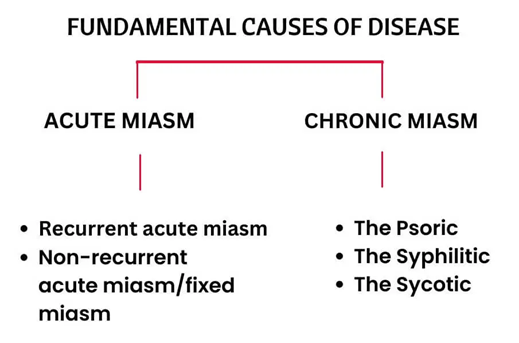
Types of Miasms
In homoeopathy, miasms are viewed as the basic root causes of long-term illnesses. They are thought to be inherited tendencies that render individuals more vulnerable to specific kinds of diseases. Although the idea of miasms is distinct from homoeopathy, it is crucial to acknowledge that their presence and influence on disease have not been scientifically proven.
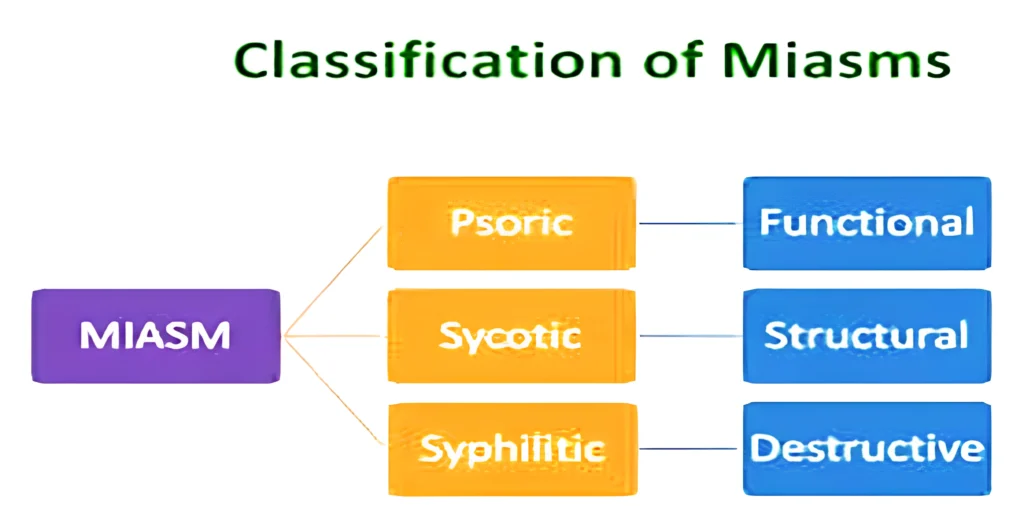
Origin of Psora – The concept of Psora was introduced by Samuel Hahnemann, the founder of homoeopathy, who characterized it as the “most ancient and most universal chronic miasm.” Hahnemann posited that Psora originated from the suppression of an itch disease, specifically related to conditions such as scabies or other dermatological issues. This suppression purportedly led to a cascade of chronic ailments that manifest over time, affecting both the mind and body. While Psora is not considered contagious in the typical sense, it is viewed as an inherited predisposition that can be transmitted through generations, suggesting a genetic component to its expression.
Psora, in the context of homoeopathy, is frequently compared to a Hydra-headed monster due to its complex nature and the wide variety of symptoms it can present. The Hydra is a legendary creature from Greek mythology that had multiple heads, and each time one was severed, two new ones would grow back in its place. This comparison effectively illustrates the persistent and versatile characteristics of Psora.
Here are the reasons why Psora is compared to a Hydra:
● Diverse Manifestations: Psora can express itself in numerous ways, impacting multiple bodily systems and mental health. It can lead to skin outbreaks, itching, allergies, asthma, digestive problems, anxiety, depression, and many other seemingly unrelated issues. Each symptom or cluster of symptoms can be regarded as a “head” of the Hydra, symbolizing a different facet of the miasm.
● Changing Symptoms: Similar to the heads of the Hydra, the symptoms of Psora can fluctuate and evolve. One symptom may lessen, only to be replaced by another, complicating the process of accurate diagnosis and treatment. This shifting characteristic reflects the miasm’s capacity to adjust and find new avenues of expression.
● Treatment Resistance: Psora can prove to be tough to treat, particularly if only the visible symptoms are targeted. Suppressing one symptom can result in the emergence of another, deeper manifestation of the miasm. This mirrors Hydra’s ability to sprout new heads when one is removed, emphasizing the necessity for a holistic treatment approach that tackles the fundamental cause of the illness.
● Dormant Tendency: Even when specific symptoms are alleviated, the core Psora miasm might remain inactive, poised to reappear under suitable circumstances. This latent inclination can be likened to Hydra’s regenerative capacity, highlighting the significance of addressing the miasm at its essence for achieving sustainable relief.
The Hydra metaphor serves as a strong reminder of the intricate nature of Psora and the difficulties it poses in homoeopathic treatment. It emphasizes the need for a thorough understanding of the miasm, its varied expressions, and its inclination to adapt and reemerge. By viewing Psora as a Hydra-headed monster, homoeopaths can be more prepared to tackle its complex nature and offer effective, long-lasting solutions.
Psora miasm symptoms – Psora encompasses a wide variety of symptoms that are both mental and physical.
1. Mental Symptoms:
● Anxiety and Worry: Individuals may experience pervasive anxiety, particularly concerning their health status or potential illness.
● Irritability and Impatience: An increased tendency towards irritability, often leading to impatience in social situations and personal interactions.
● Restlessness and Fidgeting: A constant sense of unease and the inability to remain still, leading to restless behaviours.
● Difficulty Concentrating and Forgetfulness: Challenges in maintaining focus on tasks and frequent memory lapses, contribute to frustration in daily life.
● Pessimism and Hopelessness: A general feeling of despair and a negative outlook on life, impacting emotional well-being.
2. Physical Symptoms:
● Intense Itching: Characterized by severe itching sensations, often exacerbated at night or in warm environments, disrupting sleep.
● Skin Eruptions: Includes various dermatological conditions such as eczema, psoriasis, and hives, which may vary in severity and appearance.
● Dry, Scaly Skin: The skin may appear cracked and fissured, often resulting in discomfort and potential secondary infections.
● Burning Sensations: Individuals may report burning feelings in affected skin areas, complicating daily activities.
● Weakness and Fatigue: Chronic fatigue and a general sense of physical weakness can hinder everyday functioning.
● Digestive Issues: Manifestations may include irregular bowel movements, such as constipation or diarrhoea, impacting overall health.
● Headaches and Migraines: Recurring headaches or migraines that may be linked to stress or tension caused by other Psoric symptoms.
● Joint Pain and Stiffness: Individuals may experience discomfort and stiffness in joints, contributing to mobility difficulties.
Common Homeopathic Remedies for Psora – Homeopathic treatment of Psora centres on understanding each individual’s unique symptomatology and choosing a remedy that resonates with their specific presentation.
Notable remedies include:
1. Sulphur: Recommended for intense itching, burning skin eruptions, and an aversion to warmth. Typically indicated when the skin symptoms are pronounced and disruptive.
2. Graphites: Useful for individuals with thick, sticky skin eruptions, often combined with issues such as cracked skin and digestive disturbances.
3. Calcarea carbonica: Ideal for those experiencing heightened anxiety, worry, and notable sensitivity to cold environments, frequently seen in easily fatigued individuals.
4. Lycopodium: Often prescribed for digestive complaints, such as bloating and gas, coupled with a strong aversion to social interactions, indicative of low self-confidence.
5. Arsenicum album: Suitable for individuals who suffer from burning sensations, restlessness, and heightened anxiety about their health, often leading to obsessive behaviours regarding cleanliness and order.
By tailoring treatment to the individual’s symptom profile, homoeopathy aims to restore balance and alleviate the burdens associated with Psora.
SYCOSIS: This miasm is linked to a variety of conditions often seen in the form of warts, abnormal growths, and chronic discharges from bodily orifices. Sycosis is particularly associated with the suppression of gonorrhoea, suggesting that unresolved sexually transmitted infections can lead to a chronic state of illness affecting other parts of the body. Homoeopaths recognize sycosis as a miasmatic influence that can disrupt bodily functions and contribute to a range of conditions characterized by excessive growths, indicating the need for holistic treatment strategies to tackle both the symptoms and their underlying miasmatic roots.
Sycosis: The Miasm of Excess – In homoeopathy, Sycosis is recognized as one of the three foundational miasms, alongside Psora and Syphilis. This concept posits that Sycosis arises from chronic disease processes, particularly stemming from suppressed or inadequately treated gonorrheal infections. While this miasmatic theory is central to the homoeopathic practice, it is important to note that it lacks scientific validation in mainstream medicine, which operates under a different paradigm.
Overview – Sycosis is primarily characterized by a state of excess—excessive growth, excessive bodily discharges, and excessive mental activity. This miasm can manifest through a wide range of physical and psychological symptoms, typically marked by chronicity and a propensity for proliferation in bodily tissues and mental states.

Key Characteristics of Sycosis – In homoeopathy, Sycosis is considered one of the three fundamental miasms, or chronic disease predispositions, along with Psora and Syphilis. It is believed to be the result of suppressed or improperly treated gonorrhoea infections. Sycosis is characterized by the following key features:
1. Mental Symptoms –
● Stubbornness and Fixed Ideas: Individuals with a Sycotic miasm often display unwavering stubbornness, holding fast to their opinions and beliefs. This rigidity can create barriers to personal growth, as they struggle to entertain or accept alternative viewpoints.
● Overthinking and Obsessive Thoughts: A hallmark trait of this miasm is a tendency toward excessive contemplation and obsessive thinking patterns. Individuals may get caught in cycles of rumination, fixating on details that can hinder rational decision-making and mental clarity.
● Secretiveness and Deception: Some may exhibit a tendency to be secretive or deceptive, perhaps driven by a fear of exposure or vulnerability. This desire to conceal inner thoughts can result in a lack of openness in relationships.
● Aversion to Being Touched or Approached: There can be a pronounced physical or emotional aversion to touch, making affectionate gestures or social interactions uncomfortable.
● Jealousy and Suspicion: Emotions such as jealousy and suspicion may frequently arise, often leading to interpersonal conflicts and strained relationships.
● Impulsiveness: Actions taken on a whim without considering potential consequences can be common, resulting in unpredictable behaviour and regrettable decisions.
2. Physical Symptoms:
● Warts and Other Growths: The presence of warts, particularly genital warts, is one of the most recognizable physical manifestations of Sycosis. Other types of benign growths, such as polyps and moles, may also appear.
● Joint Pains and Stiffness: Individuals may experience joint pain and stiffness, which are often exacerbated by damp or cold weather conditions. These symptoms can be indicative of underlying arthritic conditions.
● Thick, Greenish-Yellow Discharges: Discharges from mucous membranes (such as the nose, urethra, or vagina) can be profuse and characterized by a thick, greenish-yellow colouration—often a sign of underlying infection or irritation.
● Retention of Fluids: Symptoms of oedema (swelling) and water retention may occur as the body struggles to maintain proper fluid balance.
● Asthma and Respiratory Complaints: Respiratory symptoms, including asthma and other chronic respiratory issues, can be present, adding to the overall burden of the condition.
● Urogenital Problems: Individuals may suffer from urinary tract infections, increased frequency of urination, and other urogenital issues, reflecting the interconnectedness of the body’s systems.
● Sweating: Profuse sweating, particularly during nighttime, can sometimes be a distressing symptom associated with Sycosis.
Common Homeopathic Remedies for Sycosis
Homoeopathic treatment for Sycosis requires a comprehensive analysis of an individual’s specific symptom profile to select the most suitable remedy. Some commonly utilized remedies include:
1. Thuja occidentalis: Particularly effective for treating warts, especially those of a genital nature, this remedy addresses the overgrowth of tissue associated with Sycosis.
2. Medorrhinum: This nosode, derived from diseased tissue, is often indicated for chronic conditions linked to Sycosis, especially when there is a documented history of suppressed gonorrhoea.
3. Nitric Acid: This remedy is beneficial for warts, fissures, and ulcers, especially those accompanied by splinter-like pains that indicate deeper issues.
4. Causticum: Indicated for larger, cauliflower-like warts and joint pains, Causticum supports both physical and emotional aspects of the Sycotic condition.
5. Staphysagria: This remedy is especially helpful for fig warts and emotional conditions tied to suppressed anger, indignation, and past grievances.
In sum, understanding Sycosis within the framework of homoeopathy offers a rich perspective on chronic health conditions, pointing to the interplay between physical symptoms and emotional states, thereby emphasizing a holistic approach to treatment.
❖ SYPHILIS: Regarded as the most profound and destructive miasm, syphilis is associated with severe health issues, including the development of ulcers, extensive tissue destruction, and significant neurological problems. This miasm is typically linked directly to the infection of syphilis itself. The impact of syphilis on the body is far-reaching, affecting not only the physical structure but also leading to extensive and often irreversible damage if not addressed promptly. The recognition of this miasm reflects the importance of identifying and treating deep-seated infections to restore health and prevent long-term consequences.
Syphilis: The Miasm of Destruction – In the context of homoeopathy, Syphilis is recognized as one of the three primary miasms, alongside Psora and Sycosis. This classification carries the belief that Syphilis represents a chronic disease state arising from either untreated or improperly managed syphilis infections. It is crucial to note that while the miasmatic theory forms a foundational part of homoeopathic practice, it lacks scientific validation within conventional medical frameworks.
Overview – Syphilis is chiefly characterized by destruction — encompassing the disintegration of bodily tissues, the deterioration of interpersonal relationships, and a pervasive sense of self-destruction. The manifestations of this miasm present themselves through a complex array of physical and mental symptoms, frequently marked by chronicity and a propensity towards ulceration and degenerative changes.
Key Characteristics of Syphilis:
1. Mental Symptoms:
● Despair and Hopelessness: Individuals affected by a Syphilitic miasm often grapple with deep-seated feelings of despair and hopelessness. They frequently perceive their circumstances as irretrievable, fostering an overwhelming sense of doom.
● Suicidal Tendencies: The presence of suicidal thoughts and tendencies is markedly pronounced within the Syphilitic state, with individuals feeling trapped in their suffering.
● Maliciousness and Destructiveness: A worrying inclination towards malicious behaviour and destructiveness may emerge, sometimes accompanied by urges to inflict harm upon others.
● Irritability and Violence: Many individuals exhibit heightened irritability and may experience violent outbursts, driven by an underlying sense of frustration.
● Mental Confusion and Impaired Memory: Cognitive functions can become significantly compromised. This may manifest as confusion, difficulty focusing, and substantial memory lapses.
● The feeling of Isolation and Loneliness: A profound sense of isolation and alienation from others often accompanies the Syphilitic state, exacerbating feelings of loneliness.
2. Physical Symptoms:
● Ulcers: A defining characteristic of Syphilis, these ulcers can manifest on the skin, mucous membranes, or even within internal organs. They are typically deep, agonizing, and notoriously slow to heal.
● Bone Deformities: Syphilis can lead to notable bone deformities, accompanied by severe pain and necrosis (tissue death), impacting the overall structural integrity of the skeletal system.
● Neurological Problems: The disease can wreak havoc on the nervous system, causing a diverse range of neurological symptoms, including debilitating headaches, seizures, paralysis, and even forms of dementia.
● Cardiovascular Problems: Syphilis can significantly compromise cardiovascular health, leading to conditions such as heart disease, aneurysms, and various vascular complications.
● Skin Lesions: Beyond ulcers, individuals may present with various skin lesions, including rashes, papules, and pustules, which can further complicate the clinical picture.
● Chronic Pain: Persistent pain, particularly in the bones and head, can significantly affect daily functioning and quality of life.
Common Homeopathic Remedies for Syphilis
Homoeopathic treatment for Syphilis necessitates meticulous case analysis to tailor the remedy selection to the individual’s unique symptom constellation. Some widely utilized remedies for addressing this condition include:
1. Mercurius solubilis: A cornerstone remedy in the treatment of Syphilis, particularly effective when the patient exhibits ulcers, swollen glands, and a marked sensitivity to temperature fluctuations.
2. Luesinum: This nosode, derived from diseased tissue, is particularly indicated for individuals with a documented history of Syphilis or when other remedies prove ineffective.
3. Aurum metallicum: This remedy is beneficial for those experiencing bone pain, depressive states, and suicidal thoughts related to the Syphilitic miasm.
4. Asafoetida: Indicated primarily for the treatment of offensive, slow-healing ulcers and accompanying neurological symptoms, providing symptomatic relief.
5. Nitric acid: Effective in treating ulcerations, fissures, and notable splinter-like pain, addressing both physical discomfort and the associated emotional distress.
In conclusion, understanding the complexities of the Syphilitic miasm not only sheds light on its physical and mental ramifications but also assists in guiding effective homoeopathic treatment strategies.
Tubercular Miasm: a Comprehensive Examination of Psora and Syphilis Integration
In homoeopathy, the concept of Tubercular miasm is understood as a multifaceted condition that represents a complex interplay between the characteristics of Psora and Syphilis. This isn’t merely the coexistence of these two miasms but rather a distinct manifestation that synthesizes the defining elements of both. It is crucial to bear in mind that miasmatic theory is a foundational aspect of homoeopathy and does not find acknowledgement within conventional medical frameworks.
Overview
The Tubercular miasm is closely linked to a predisposition toward tuberculosis and other debilitating wasting diseases. It embodies a unique amalgamation of the intense itching and skin eruptions associated with Psora, alongside the destructive tendencies and ulcerative qualities attributed to Syphilis. This union engenders a specific state characterized by restlessness, pronounced weakness, and an alarming propensity for rapid health deterioration.
Key Characteristics of the Tubercular Miasm:
1. Mental Symptoms:
● Restlessness and Fidgeting: Individuals often display significant restlessness both physically and mentally. This can manifest as an inability to remain still, persistent fidgeting, and a continual craving for change or new stimuli in their environment.
● Dissatisfaction and Irritability: A prevalent sense of dissatisfaction with life typically accompanies heightened irritability, where individuals may exhibit a low threshold for frustration or anger in response to minor irritants.
● Anxiety and Fear, especially of Consumption: Individuals may experience pervasive anxiety, particularly regarding their health, with an acute fear of contracting tuberculosis (historically known as consumption) or other grave illnesses. This fear can dominate their thoughts and affect their daily functioning.
● Changeability and Impulsiveness: A marked tendency toward emotional instability, with abrupt changes in mood, desires, or plans. This impulsiveness often leads to incomplete tasks and disrupted routines.
● Weakness and Fatigue: A significant aspect of the Tubercular miasm is the presence of both mental and physical fatigue. Affected individuals may struggle with low energy levels and often feel overwhelmed by routine tasks.
2. Physical Symptoms:
● Respiratory Issues: The lungs and the entire respiratory system become a primary focus in individuals with Tubercular miasm. Common manifestations include a heightened susceptibility to respiratory infections, chronic coughs, bronchitis, pneumonia, and asthma.
● Weakness and Emaciation: A distinguishing symptom is severe weakness coupled with significant weight loss and emaciation, often occurring despite a normal or even increased appetite.
● Rapid Deterioration: Individuals may experience a dramatic decline in health, particularly evident during acute or severe illnesses. This swift deterioration can raise concerns regarding their overall prognosis.
● Glandular Swelling: Swelling of lymph nodes is frequently observed, particularly in regions such as the neck and chest, corresponding with the body’s efforts to fight infections.
● Skin Eruptions: The skin is often affected, presenting conditions that include the intense itching of Psora merged with the ulceration and lesions commonly associated with Syphilis. Manifestations such as eczema, psoriasis, and other dermatological issues might arise.
● Night Sweats: Profuse sweating during the night is a characteristic symptom, often resulting in wet bedding and causing significant discomfort.
● Sensitivity to Cold and Damp: Symptoms are often exacerbated by exposure to cold, damp conditions, making individuals particularly vulnerable to these environments.
Common Homeopathic Remedies for the Tubercular Miasm
Homoeopathic treatment for the Tubercular miasm necessitates a thorough analysis of the individual case, as each presentation may vary.
Some frequently utilized remedies include:
1. Tuberculinum: A nosode derived from tubercular tissue, typically employed for patients exhibiting a strong diathesis for tuberculosis or possessing a familial history of the disease.
2. Bacillinum: Another nosode similar in function to Tuberculinum, targeting similar miasmatic conditions.
3. Phosphorus: Primarily indicated for respiratory issues, this remedy is known for addressing weakness and a tendency toward haemorrhage.
4. Calcarea carbonica: This remedy is particularly useful for individuals who exhibit a chilly constitution, persistent sweating, and anxiety.
5. Lycopodium: Often indicated for symptoms of weakness, digestive disturbances, and specifically a fear of public speaking or social situations.
In summary, comprehending the nuances of the Tubercular miasm is vital for appropriate homoeopathic treatment. By assessing both mental and physical symptoms thoroughly, practitioners can tailor their approaches effectively to address the unique health challenges presented by individuals embodying this miasmic disposition.
In addition to the three primary miasms traditionally recognized in homoeopathy, practitioners have identified several other significant miasms that play a crucial role in understanding various disease processes. These include:
Cancer Miasm:
This miasm is specifically associated with the development of cancerous conditions and is characterized by a tendency for uncontrolled cell proliferation and the resultant destruction of healthy tissues. It often reflects a deeper, underlying dysfunction in the body’s regulatory mechanisms that leads to carcinogenesis, including genetic mutations and immune system evasion.
Psora-Sycosis Miasm
This miasm represents a hybrid of the Psora and Sycosis miasms. It is characterized by a combination of symptoms including intense itching, diverse skin eruptions, and various forms of excessive tissue growth such as warts and polyps. This dual miasm may indicate a complex interplay between skin-related ailments and systemic issues related to fluid retention, hormonal imbalances, and chronic infections.
Psora-Syphilis Miasm
Similarly, this miasm is a fusion of the Psora and Syphilis miasms. It displays symptoms such as severe itching, skin eruptions resembling psoric manifestations, and destructive processes that can lead to progressive tissue damage and systemic health decline. The presence of this miasm suggests a conflation of chronic disease patterns reflecting both skin affliction and severe internal degeneration often seen in advanced syphilitic conditions.
These additional miasms provide a more comprehensive framework for assessing patient health in homoeopathy, offering deeper insights into the underlying causes and potential treatment approaches for chronic diseases.
How Does Understanding Miasms Improve Treatment?
In homoeopathy, the concept of miasms – chronic disease predispositions – plays a significant role in understanding the root cause of illness and tailoring treatment for better outcomes. While the miasmatic theory is specific to homoeopathy and not a part of conventional medicine, it offers a framework for homoeopaths to approach chronic disease.
❖ Tailoring Remedies Based on a Patient’s Dominant Miasm – Understanding a patient’s dominant miasm is crucial for a homeopath, as it allows for the selection of remedies that target the fundamental susceptibility to disease, rather than merely alleviating superficial symptoms. Each miasm presents a distinct and characteristic pattern of mental, emotional, and physical symptoms that can provide valuable insights into the individual’s overall health.
For instance, the Psora miasm, which is associated with symptoms such as chronic itching, various skin eruptions, and underlying anxiety, reflects a state of disease that often extends beyond the skin. A homoeopath may find that a remedy like Sulphur is particularly beneficial for individuals exhibiting this miasm, as it can stimulate the vital force and promote a deeper healing process.
Conversely, a patient exhibiting a Sycotic miasm, often characterized by the presence of warts, benign growths, and personality traits such as stubbornness and a tendency toward assertiveness, may respond more favourably to a remedy like Thuja. This remedy is recognized for its ability to address the underlying miasmatic patterns that contribute to the person’s health challenges, facilitating a more profound and lasting cure.
By meticulously recognizing these unique patterns associated with each miasm, a skilled homoeopath can select remedies that resonate deeply with an individual’s vital force, ultimately restoring balance and promoting genuine healing.
❖ Addressing Root Causes Rather Than Just Symptoms – One of the core principles of homoeopathy is the holistic approach to treatment, emphasizing the need to address the entire individual rather than merely focusing on isolated symptoms. Central to this philosophy are miasms, which represent the foundational layers of an individual’s susceptibility to various diseases. Miasms are essentially inherited predispositions or chronic states of imbalance that can influence a person’s health over generations. By thoroughly understanding the specific miasm at play, a homoeopath can effectively target the root cause of a chronic ailment, thereby moving beyond mere suppression or superficial alleviation of symptoms.
This comprehensive approach can facilitate deeper and longer-lasting healing outcomes. For example, when treating eczema, a common skin condition, relying solely on topical creams may provide temporary relief from the visible skin eruption. However, this method fails to address the underlying miasm, such as Psora, which may be the driving force behind the condition. A skilled homoeopath would identify the interplay of symptoms and the patient’s overall constitution, ultimately selecting a constitutional remedy tailored to address the Psora miasm. This aims not only to resolve the immediate skin issues but also to heal the underlying factors contributing to the condition, significantly reducing the likelihood of future flare-ups and promoting overall well-being.
❖ The Role of Miasmatic Understanding in Preventive Healthcare – Miasmatic understanding plays a significant role in preventive healthcare, particularly within the realm of homoeopathy. By identifying an individual’s miasmatic predisposition—not just based on current health status but also considering genetic factors and environmental influences—a homoeopath can pinpoint potential weaknesses and susceptibilities specific to that individual. This comprehensive evaluation allows for personalized guidance on lifestyle choices, dietary recommendations, and the selection of suitable homoeopathic remedies tailored to various health scenarios.
For instance, consider a child who has a family history of tuberculosis, indicating a potential Tubercular miasm. In such cases, a homoeopath may recommend specific prophylactic measures, such as homoeopathic interventions like Bacillinum, to bolster the child’s immune system and enhance their natural resistance to infectious agents. Additionally, constitutional remedies may be suggested to address deeper underlying imbalances and promote overall vitality.
While miasms are not acknowledged in conventional medicine, the miasmatic approach used by homoeopaths offers a structured framework for supporting long-term health and well-being. It emphasizes the interconnectedness of physical, emotional, and environmental factors while fostering a proactive strategy for health maintenance that can empower individuals to make informed decisions about their health journey.
Conclusion:
In homoeopathy, the concept of miasms—defined as hereditary or acquired chronic disease predispositions—holds a crucial place in comprehending the root causes of illness and attaining lasting healing. Miasms can be understood as underlying factors that influence an individual’s health, manifesting in various physical, mental, and emotional symptoms. As we delve deeper, we recognize that each miasm, including Psora, Sycosis, and Syphilis, along with their combinations such as the Tubercular miasm, reveals a distinct pattern of symptoms that can affect overall well-being.
For instance, Psora is often associated with conditions characterized by dryness and itching, suggesting a fundamental state of vitality compromise. In contrast, Sycosis may present with symptoms indicating excess fluid production, which can be linked to conditions like warts or recurring infections.
Syphilis tends to correlate with more destructive and degenerative processes in the body. By identifying these patterns, homoeopaths are equipped to personalize treatment, tailoring remedies to align with an individual’s specific constitution. This holistic approach emphasizes the totality of the person, which is the hallmark of homoeopathy, enabling a deeper and more transformative healing experience.
We strongly advocate consulting with a trained and qualified homoeopath for personalized treatment. Engaging in self-treatment can have detrimental effects, as it may merely suppress symptoms without tackling the underlying miasm, potentially complicating health issues in the long run.
A skilled homoeopath will conduct a comprehensive assessment, meticulously taking a detailed case history that incorporates various facets of your being—physical health, emotional state, lifestyle factors, and familial health history—to identify your dominant miasm. This thorough evaluation facilitates the prescription of the most appropriate remedy tailored to your unique needs, promoting true healing.
Take the first step towards better health today! Don’t allow chronic illness to impede your quality of life any longer. Visit Vishudh Kaya Pain Relief and Multispecialty Clinic for a consultation and to uncover the transformative power of homoeopathy. Explore a pathway to genuine and lasting well-being, where your health is understood as a whole.
🌿 Experience the Power of Homeopathy at Vishudh Kaya Clinic! 🌿
Looking for safe, natural, and effective homoeopathy treatment in Kharar? At Vishudh Kaya Pain Relief & Multispeciality Clinic, our expert homoeopathy practitioners provide personalized treatment for chronic diseases, allergies, skin disorders, pain management, and more!

